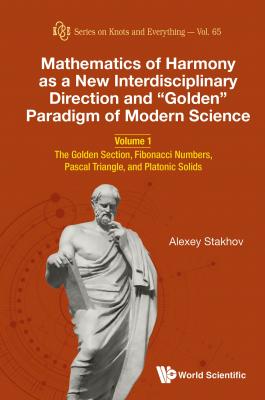ТОП просматриваемых книг сайта:
Mathematics of Harmony as a New Interdisciplinary Direction and “Golden” Paradigm of Modern Science. Alexey Stakhov
Читать онлайн.Название Mathematics of Harmony as a New Interdisciplinary Direction and “Golden” Paradigm of Modern Science
Год выпуска 0
isbn 9789811206382
Автор произведения Alexey Stakhov
Жанр Математика
Серия Series On Knots And Everything
Издательство Ingram
3.6 Algebraic Equations for the Golden p-Proportion and Vieta’s Formulas
3.7 Binet’s Formulas for the Fibonacci p-Numbers
3.8 Binet’s Formulas for the Lucas p-Numbers
Chapter 4. Platonic Solids: From Plato’s Cosmology to Fullerenes and Quasicrystals
4.1 The Golden Section in Platonic Solids
4.2 Archimedean Truncated Icosahedron and Stellate Polyhedra
4.3 The Mystery of the Egyptian Calendar
4.4 Dodecahedral–Icosahedral Doctrine
4.5 Johannes Kepler: From “Mystery” to “Harmony”
4.6 Icosahedron as the Main Geometric Object of Mathematics
4.7 Usage of the Regular Polyhedra in the Fine Art
4.8 Dan Shechtman’s Quasicrystals
4.10 Platonic Solids and New Ideas in the Theory of Elementary Particles
Preface to the Three-Volume Book
Continuity in the Development of Science
Scientific and technological progress has a long history and passed in its historical development several stages: The Babylonian and Ancient Egyptian culture, the culture of Ancient China and Ancient India, the Ancient Greek culture, the Middle Ages, the Renaissance, the Industrial Revolution of the 18th century, the Great Scientific Discoveries of the 19th century, the Scientific and Technological Revolution of the 20th century and finally the 21st century, which opens a new era in the history of mankind, the Era of Harmony.
Although each of the mentioned stages has its own specifics, at the same time, every stage necessarily includes the content of the preceding stages. This is called the continuity in the development of science.
It was during the ancient period, a number of the fundamental discoveries in mathematics were made. They exerted a determining influence on the development of the material and spiritual culture. We do not always realize their importance in the development of mathematics, science, and education. To the category of such discoveries, first of all, we must attribute the Babylonian numeral system with the base 60 and the Babylonian positional principle of number representation, which is the foundation of the, decimal, binary, ternary, and other positional numeral systems. We must add to this list the trigonometry and the Euclidean geometry, the incommensurable segments and the theory of irrationality, the golden section and Platonic solids, the elementary number theory and the mathematical theory of measurement, and so on.
The continuity can be realized in various forms. One of the essential forms of its expression are the fundamental scientific ideas, which permeate all stages of the scientific and technological progress and influence various areas of science, art, philosophy, and technology. The idea of Harmony, connected with the golden section, belongs to the category of such fundamental ideas.
According to B.G. Kuznetsov, the researcher of Albert Einstein’s creativity, the great physicist piously believed that science, physics in particular, always had its eternal fundamental goal “to find in the labyrinth of the observed facts the objective harmony”. The deep faith of the outstanding physicist in the existence of the universal laws of the Harmony is evidenced by another well-known Einstein’s statement: “The religiousness of the scientist consists in the enthusiastic admiration for the laws of the Harmony” (the quote is taken from the book Meta-language of Living Nature [1], written by the outstanding Russian architect Joseph Shevelev, known for his research in the field of Harmony and the golden section [1–3]).
Pythagoreanism and Pythagorean MATHEM’s
By studying the sources of the origin of mathematics, we inevitably come to Pythagoras and his doctrine, named the Pythagoreanism (see Wikipedia article Pythagoreanism, the Free Encyclopedia). As mentioned in Wikipedia, the Pythagoreanism originated in the 6th century BC and was based on teachings and beliefs of Pythagoras and his followers called the Pythagoreans. Pythagoras established the first Pythagorean community in Croton, Italy. The Early Pythagoreans espoused a rigorous life and strict rules on diet, clothing and behavior.
According to tradition, Pythagoreans were divided into two separate schools of thought: the mathematikoi (mathematicians) and the akousmatikoi (listeners). The listeners had developed the religious and ritual aspects of Pythagoreanism; the mathematicians studied the four Pythagorean MATHEMs: arithmetic, geometry, spherics, and harmonics. These MATHEMs, according to Pythagoras, were the main composite parts of mathematics. Unfortunately, the Pythagorean MATHEM of the harmonics was lost in mathematics during the process of its historical development.
Proclus Hypothesis
The Greek philosopher and mathematician Proclus Diadoch (412–485 AD) put forth the following unusual hypothesis concerning Euclid’s Elements. Among Proclus’s mathematical works, his Commentary on the Book I of Euclid’s Elements was the most well known. In the commentary, he puts forth the following unusual hypothesis.
It is well known that Euclid’s Elements consists of 13 books. In those, XIIIth book, that is, the concluding book of the Elements, was devoted to the description of the geometric theory of the five regular polyhedra, which had played a dominant role in Plato’s cosmology and is known in modern science under the name of the Platonic solids.
Proclus drew special attention to the fact that the concluding book of the Elements had been devoted to the Platonic solids. Usually, the most important material, of the scientific work is placed in its final part. Therefore, by placing Platonic solids in Book XIII, that is, in the concluding book of his Elements, Euclid clearly pointed out on main purpose of writing his Elements. As the prominent Belarusian philosopher Edward Soroko points out in [4], according to Proclus, Euclid “had created his Elements allegedly not for the purpose of describing geometry as such, but with purpose to give the complete systematized theory of constructing the five Platonic solids; in the same time Euclid described here some latest achievements of mathematics”.
It is for the solution of this problem (first

